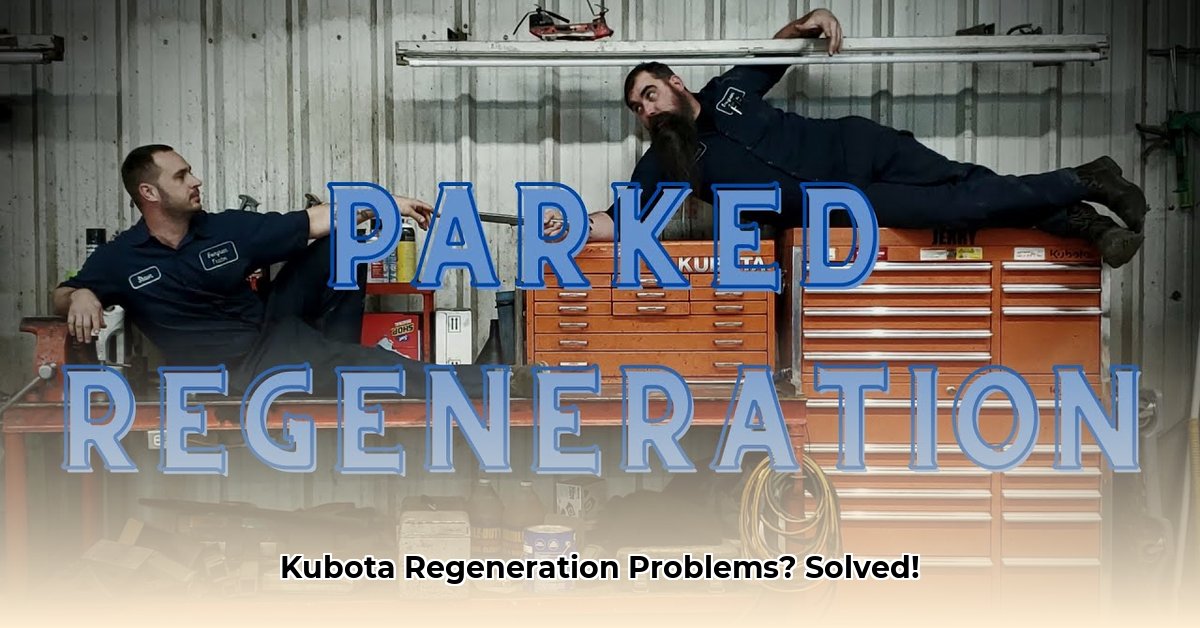
This guide provides comprehensive instructions for troubleshooting and resolving Kubota tractor regeneration problems. Understanding your tractor's regeneration system is key to preventing costly repairs and maximizing uptime. We'll cover everything from passive and active regeneration to diagnosing specific issues and performing preventative maintenance. For more in-depth information, check out this helpful guide: Kubota Regeneration Guide.
Understanding Kubota Regeneration Systems
Kubota tractors utilize Diesel Particulate Filters (DPFs) to remove soot and particulate matter from exhaust gases, meeting emission standards. The DPF regeneration process cleans this filter. This process occurs in two ways:
Passive Regeneration: This automatic process occurs during normal operation at higher engine speeds and under heavier loads. The exhaust heat naturally burns off soot buildup in the DPF. It's similar to the self-cleaning function in some home ovens.
Active Regeneration: This process is triggered when passive regeneration isn't sufficient to clean the DPF. The system injects additional fuel, increasing the exhaust temperature to burn off accumulated soot. Think of this as a more intensive cleaning cycle for the DPF.
Common Regeneration Problems
Several issues can hinder the regeneration process, leading to reduced performance and warning lights:
DPF Clogging: This is often caused by frequent short trips that prevent the DPF from reaching the temperature needed for passive regeneration. Incorrect fuel or oil type can also contribute. A clogged DPF restricts exhaust flow, impacting engine performance.
Sensor Malfunctions: Various sensors monitor the regeneration process. A faulty sensor can prevent active regeneration from initiating or provide inaccurate data leading to incorrect actions by the system.
ECU (Electronic Control Unit) Issues: The ECU controls the entire regeneration process. A malfunctioning ECU can hinder or prevent proper regeneration. This is a significant issue requiring professional diagnosis.
Troubleshooting Steps: A Step-by-Step Approach
If your Kubota tractor displays regeneration problems (warning lights, reduced performance), follow this troubleshooting guide:
Check Warning Lights: Consult your owner's manual to understand the meaning of any illuminated warning lights on your dashboard. This is your first diagnostic step.
Consult the Owner's Manual: Your owner's manual provides valuable information specific to your tractor model, including troubleshooting guides and error code explanations.
Inspect the DPF (If Accessible): Carefully inspect the DPF for excessive soot buildup. Caution: This process requires specific knowledge and tools, and may be unsafe for inexperienced individuals.
Retrieve Diagnostic Trouble Codes (DTCs): Many Kubota models have onboard diagnostics. Consult your owner's manual to retrieve any DTCs related to the regeneration system. These codes give clues to the problem's source.
Seek Professional Assistance: If you cannot identify the issue after the above steps, contact a Kubota-certified technician for professional diagnosis and repair.
Preventative Maintenance: Avoiding Problems
Regular preventative maintenance is crucial for preventing regeneration issues:
Regular Oil Changes: Use the correct oil type and grade specified in your owner's manual, and maintain a consistent oil change schedule. Incorrect oil can increase soot production.
Avoid Frequent Short Trips: Allow the engine to reach its normal operating temperature regularly; short trips hinder passive regeneration.
Monitor Oil Levels: Regularly check and maintain proper oil levels; low oil can increase wear and soot.
Fuel Filter Maintenance: Periodically replace your fuel filter according to the manufacturer's recommendations. Contaminants in the fuel can negatively impact your DPF.
Solutions and Repairs
Depending on the diagnosis, several solutions might be necessary:
Passive Regeneration: Often, extended operation at higher RPMs allows passive regeneration to successfully clear soot buildup.
Forced Regeneration: This process requires specialized equipment and should be performed by a qualified technician. It forces a more thorough cleaning cycle.
DPF Cleaning: A professional DPF cleaning can sometimes restore functionality to a clogged filter, offering a less expensive alternative to replacement.
DPF Replacement: In cases of severe damage or repeated clogging, DPF replacement is the only option. This is a more costly repair.
Dealer Intervention: When to Call a Professional
For complex issues or when troubleshooting proves unsuccessful, contact your local Kubota dealer. They possess the specialized tools, knowledge, and experience for thorough diagnosis and repair, including forced regeneration procedures. This ensures correct repair and avoids further damage.
Key Takeaways:
- Understanding your Kubota's regeneration system is crucial for preventing costly repairs.
- Regular preventative maintenance significantly reduces the likelihood of DPF-related problems.
- Professional assistance is often necessary for diagnosing and repairing complex regeneration issues.
- A timely response to warning signs prevents more extensive damage and downtime.